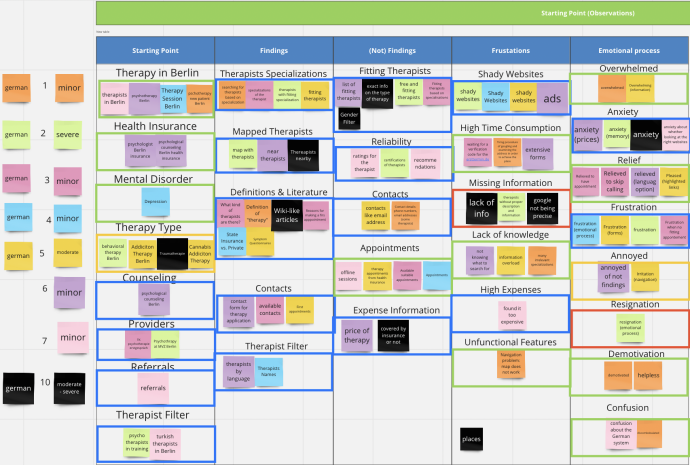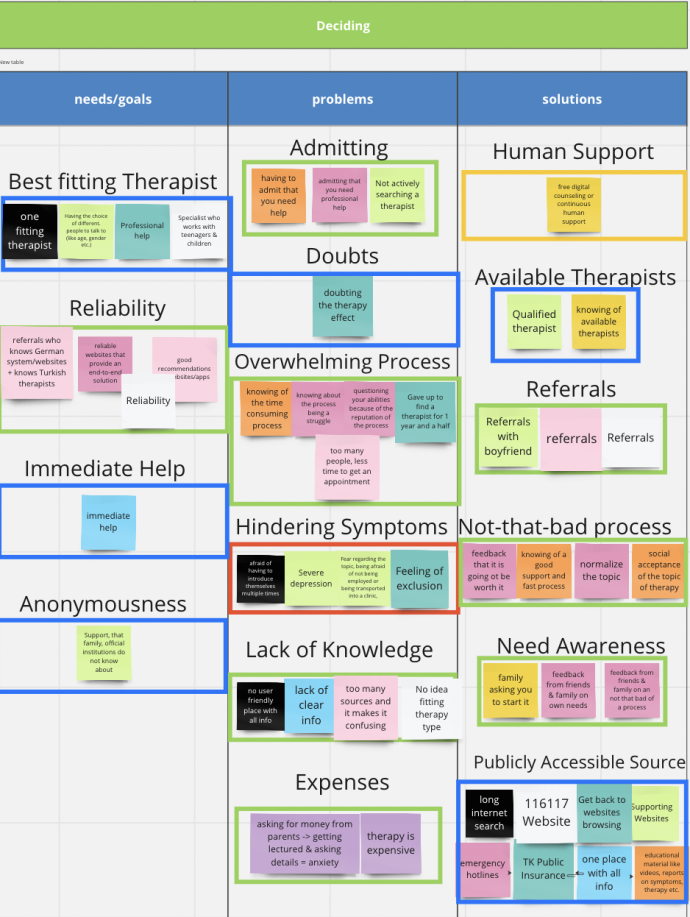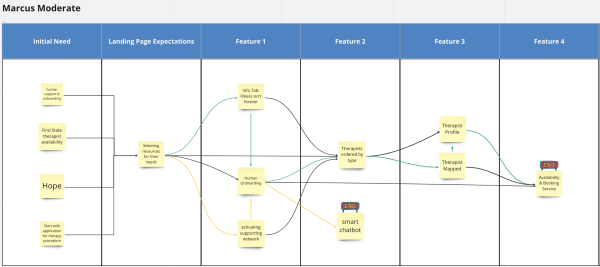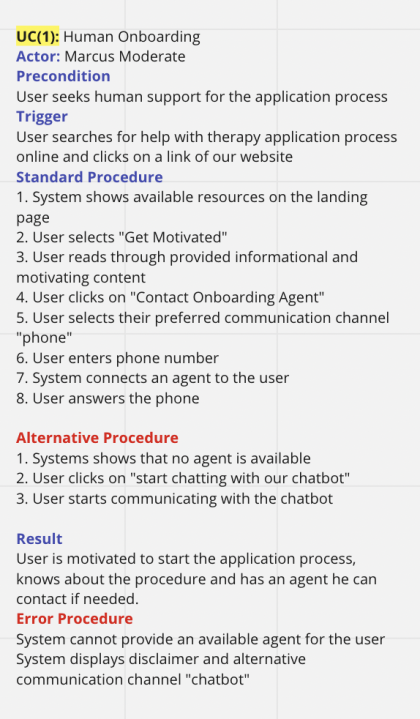Difference between revisions of "Therapy Finding & Well-being App"
(→Contextual Inquiry Analysis) |
(→Personas) |
||
| Line 230: | Line 230: | ||
Creating personas was a crucial step, as they represent how a user would interact with the product and help through the design process. Therefore, all the personas are based solely on the CI participants’ needs, goals, motivations, and behaviors. It also included a short scenario about each personas, accompanied with marital and education status, housing, age, occupation, and where they are from. Their most prominent feature was the severity of their symptoms. | Creating personas was a crucial step, as they represent how a user would interact with the product and help through the design process. Therefore, all the personas are based solely on the CI participants’ needs, goals, motivations, and behaviors. It also included a short scenario about each personas, accompanied with marital and education status, housing, age, occupation, and where they are from. Their most prominent feature was the severity of their symptoms. | ||
| − | Here are the first draft of personas (for the final version see | + | Here are the first draft of personas (for the final version see -> Focus Group Analysis: |
{| | {| | ||
Revision as of 18:02, 7 July 2023
Contents
Purpose
The ideation process for finding our product idea and the purpose of it did start with brainstorming. Each group member verbally listed the themes they would like to do and not to do. At the end of the brainstorming session, it was concluded that the common theme is psychology and mental health. One of the teammates mentioned the problems in Germany, are the difficulty of finding a therapist appointment and being informed during this process. The understanding of the potential user need for an app in this situation was aided by this.
A Miro board was created to write down the ideas about the potential purposes of the app then they were rated with star stickers. Based on the ratings, purpose, and vision were concluded. After that, the same board was used for the further documentation and it became the backbone of this project.
Our Miro Board: https://miro.com/app/board/uXjVMS20kNg=/?share_link_id=30836837161
Purpose: To guide students through the process of finding a therapist while assisting them in improving their mental health on the way.
Target Group: Students who are feeling overwhelmed with the complex process of finding a therapist or are struggling with mental illness that is preventing them from seeking help.
Vision: Be the #1 end-to-end therapy guidance app for students in Germany.
Similar Apps
• Psychotherapiesuche (a part of the "Psychotherapie-Informationsdienst" (PID), which is a service offered by the "Berufsverband Deutscher Psychologinnen und Psychologen" (Professional Association of German Psychologists) to provide information and assistance with finding a suitable psychotherapist. Includes features, such as a guideline for the therapy and insurance process, necessary hotlines, and therapist filters.) https://www.psychotherapiesuche.de
• BetterHelp (an online therapy app that provides access to licensed therapists via a smartphone or computer. Its purpose is to make therapy more accessible and convenient for individuals seeking mental health support.) https://www.betterhelp.com
• DoctoLib (booking platform to improve healthcare accessibility. It enables patients to find a nearby physician & view their availability and book appointments & access medical records. -> For doctors, Doctolib offers a full-range service to improve bookings.) https://www.doctolib.de
• Taxfix (German company. App-based online tax preparation service designed to make the process of filing taxes easier and more efficient for individuals.) https://taxfix.de
• Wohnungsbot (helps the process of finding a suitable apartment for you in Berlin. It connects to your ImmoScout account to find flat postings based on your filter and write automated, personalized application messages for you.) https://wohnungsbot.de
Contextual Inquiry
The contextual inquiry (CI) was conducted to observe how university students who have experiences with mental health and therapy (including those who seek/consider therapy and are currently in therapy) use current platforms and sources to find a therapist and what they feel through this process.
Participants
Interviews were conducted with 15 participants in total. 10 participants were university students in Germany who have experiences with mental health and therapy. Five of the participants were therapists, who work in Germany and focus on students.
Method
As a method, a combination of observation and semi-structured interviews was used. The questionnaire was created (see Interview Questionnaire) based on the motivation to understand what the users look and need for the most in this process and how these can contribute to the development of future scenarios.
Procedure
Convenience sampling was used to recruit the participants. The 20-minute interviews took place via phone or online video meeting tools. During the observation, consensual screen recording was used. Data collection was carried out through spreadsheets and analyzed by using thematic analysis.
Interview Questionnaire
FOR THERAPISTS
1) How do your clients approach you?
2) Differences in approaches from students?
3) Do you have any needs when it comes to the process of potential clients approaching you?
4) Do you have ideas on how the process of approaches could be improved?
FOR STUDENTS
Introduction
1) Introduce yourself and explain the purpose of the interview.
2) "This interview is confidential and there are no right or wrong answers. It is a safe space for sharing what you feel like."
3) Can you tell me about your current status and your experiences with mental health and therapy?
Observation of Actual Behavior
1) How would you typically start your process of searching for a therapist, using your preferred method (e.g. internet search, insurance provider, referrals)? Please think out loud and tell us your reasoning behind their actions. (ask for consent to screen record.)
2) Observe their behavior and take notes on any obstacles or barriers they encounter. (Starting point, Needs, Websites/Apps visits, Findings, Not Findings, Features, Frustrations).
3) How would you describe your emotional states throughout the search process?
Goals, Needs & Criteria
As a student:
1) What are your goals/needs that motivate you to do this process?
2) Criteria for deciding on what support/platform to use?
Problems Faced Throughout the Process
As a student:
1) Were there any challenges before starting your search for a therapist?
2) How did you go about finding a therapist? What sources did you use (e.g. internet, referrals, insurance provider)?
3) What are the main challenges you have faced, or are currently facing when trying to find a therapist?
4) Have you ever encountered any obstacles or barriers when applying for a therapist?
Potential App Functionalities Throughout the Process
As a student:
1) What kind of functionalities would encourage you to start the process?
2) What kind of functionalities would have helped you overcome the challenges you faced when trying to find a therapist?
3) What kind of functionalities would make the process of applying for a therapist more efficient?
Feedback on Potential App Features
1) If an app existed to guide you through the process of finding a therapist, what kind of features would be most helpful or appealing to you?
Feedback on Related Solutions
1) What kind of solutions have you used before and what did you like/dislike about them?
2) Are you aware of other offers and what do you know about them?
Closing
“Thank you for your time and insights! You can also share if there is anything else you would like to add on this topic.”
Contextual Inquiry Analysis
1. Data Transcription
Before the data collection, a spreadsheet was created for the data transcription after conducting interviews (see Appendix I). Three different sheets were created: Observation, Patient Interviews, and Therapist Interviews.
Spreadsheet: https://docs.google.com/spreadsheets/d/1mxhc3gFBtW7loRJOFoN9qvGt1jy-aD5nrX16MP9z5F4/edit?usp=sharing
• Patient Interviews sheet included: Warm Up – Goals- Needs & Criteria – Problems faced throughout the process – Potential app functionalities through the process – Feedback on potential app features – Feedback on related solutions - Closing.
Example of the Patient Interview sheet:
• The observations sheet included these main titles: Starting Point – Websites/App Visits – Findings/Not Findings – Features – Frustrations – Emotional Processes – Device.
Example:
• Therapist Interviews sheet included: The four questions that were asked during the interview as main titles.
Example:
2. Coding
After the transcription, a thematic analysis was conducted. Thematic analysis is used to analyze qualitative data and identify the most important patterns/themes of it. To identify the most important patterns, the data was reduced to keywords as coding. To do that, each participant (10 students, 5 therapists), was assigned a color, and sequentially, their insights were written on sticky notes on Miro. After the coding process, the grouping process began.
3. Grouping
A table for grouping codes was created with five main titles and three sub-titles for the interview part & eight titles (same as the spreadsheet) for the observation part.
• Participant interview:
Main titles were: Background, Deciding, Searching, Applying, and Design. Sub-titles were the same for each category: needs/goals, problems, and solutions.
- The background indicates the participant’s experiences with therapy, while the others indicate what they experience during that process (for example, the step for deciding on a therapist).
The codes were matched with main titles, with the corresponding groups they belong to. Recurring themes in codes defined as different subtitles. For example, several participants stated that they lack information about the therapy process in deciding steps. Therefore, this recurring theme was labeled “lack of knowledge” as a sub-title of Deciding problems.
After the code grouping, four sub-groups were created based on the severity of the participant’s symptoms/needs: minor, moderate, severe, and all levels. For example, for a code group to be labeled as "severe", it should either: include the majority of "severe" participants’ answers (2 and 10. participant) or only them. Same process was applied to the observation table as well. This categorization helped to shape personas and to see how different their needs/goals and frustrations are.
Here is the example of (1) severity labels, (2) observation table, and (3) a part of the participant interview table:
|
|
• Therapist interview:
- For therapist interviews, their answers are coded based on the recurring themes as well. Both the therapist interviews and the design part were analyzed for the design phase of the product. Since the main purpose of this step was to understand potential users’ needs, the team did not put too much emphasis on therapist interviews and the design category for the next step.
4. Interpretation
Interpretation was the last step of the contextual inquiry analysis. It included each main title of the patient interview, and four categories for the interpretation: a summary part, blockers, solutions, and derived app features. An example of the table is:
- The interpretation part, like the therapist interview table, was mainly created to be used in the prototyping process, therefore, this part was not used to create personas, but to deduct potential ideas for the features.
Personas
As a result of the contextual inquiry analysis, three different types of user targets were determined as Personas: Mina Minor, Marcus Moderate, and Sabrina Severe.
Creating personas was a crucial step, as they represent how a user would interact with the product and help through the design process. Therefore, all the personas are based solely on the CI participants’ needs, goals, motivations, and behaviors. It also included a short scenario about each personas, accompanied with marital and education status, housing, age, occupation, and where they are from. Their most prominent feature was the severity of their symptoms.
Here are the first draft of personas (for the final version see -> Focus Group Analysis:
Focus Group
After understanding the initial needs and frustrations of the potential users, a focus group was needed to comprehend potential users’ pain points and expectations better and to structure the design direction.
The Focus group method was a face-to-face workshop and included five participants who already participated in Contextual Inquiry. One group member conducted the workshop by acting both as an observer and a facilitator. The duration of the focus group was 90 minutes.
Before the workshop, Contextual Inquiry observations were revisited, and a table was created (see below) on Miro. The sticky notes underneath the “Initial Need” were created based on the personas’ goals. The sticky note options in landing page expectations and features are deduced from the contextual inquiry observations. For each persona, the team created different scenarios to show how a persona can fulfill their different needs when interacting with this product. The purpose was to compare the teams’ scenarios with the scenarios that the focus group will create.
Bird-eye view of the table:
A close-up example for Sabrina Severe:
Miro was used as the workshop tool. There were two workshop tasks. The first one was to choose and evaluate personas. The second one was to create scenarios about how these personas would interact with the product when they have specific purposes. The purpose and interaction steps were given to the participants as sticky notes so that they can drag them to the designated spaces and use arrows to indicate navigation. However, they were free to add additional steps or interactions if they wanted. The task did end when they put the last sticky note on the “end-point” stage.
The planned focus group structure:
1. Check-In [5 Minutes]
2. User Personas
- Who are our personas? [10 Minutes]
- Review our personas [15 Minutes]
3. User Scenarios
- Select an initial need and draft your scenario [3x10 minutes]
- Present one of your scenarios (5x5minutes)
4. Check-Out [5 Minutes]
focus group board and link and results
Focus Group Analysis
The main purpose of the focus group analysis is to identify patterns and themes that emerge from group discussions, and understand users' needs & expectations with the products' navigation, and potential features. This information was also needed for:
• updating the personas if necessary,
• updating the scenarios that was made before the focus group,
• creating use cases,
• creating storyboards,
• future design decisions.
1. Personas
After the evaluation of all the feedback on each persona that was made by the workshop participants, the team decided to update personas. An example for Sabrina Severe persona feedback:
- As it can be seen in the example, participants found the word "struggling" was an underestimation of severe symptoms, since a person who has severe mental struggles will likely not "struggle" but is "nearly or completely unable" to start the therapy process.
Updated Personas
For the updated versions, the team decided to change the photos to avoid using real people's picture. Personas were made to represent a group of users based on their severity, however these photos can create an impression that the persona based on an actual user. To reduce misunderstandings and possible visual biases, illustrations were selected for representations.
2. Scenarios
- Based on the scenarios that were made by the participants for all personas (4x4x4), a three-table summary (one per persona) was created by the team. The aim was to see the navigation clearly and finalize the scenarios. An example of the summary table:
The goal was to compile all the scenarios created by the participants into one single scenario that includes all possible navigations and features.
3. Use Cases
Based on the scenarios that the participants created & the final versions that the team made, the next step was creating a use case. A use case initially represents an interaction between the user and the system, with a sequence of simple steps. Starting point of a use case is the user's goal and the endpoint is when the user achieves their goal (e.g., start: book an appointment - end: appointment confirmation).
In the beginning, the use cases were made as a template on the Miro board, to understand the interaction clearly. The use cases were based on scenarios, and a use case was created for each persona.
The second step was to visualize the template in Photoshop. However, the use case that was made did include more than one specific use case (see the picture below right). Therefore, (below left), from the visual, a specific use case which is a crucial step for the product (Human Onboarding) was selected, and explained in detail to provide a clear understanding.
To further visualize our results up to this point, we created the template in Photoshop to show the development of our Use Cases. Although the illsutration was not further needed for specific research, it was used as an internal reference for future steps & work.
4. Storyboard
For a final visual representation, which was inferred from the focus group analyses, a storyboard (including nine sketches) was drawn. Unlike use cases, storyboards focus on a bird's eye user journey instead of being detailed and text-heavy on functional requirements. Storytelling and creativity can support a shared understanding of the users and their journey with the product, among designers and stakeholders. Here is the storyboard of "Human Onboarding Use Case":






















